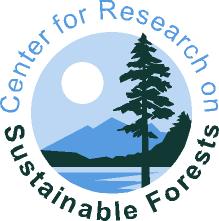Frequently Asked Questions

What is CRSF?
CRSF is a UMaine research center that brings together researchers and funding to advance understanding about the region’s forest resources and forest-based economy. CRSF is part of UMaine’s Signature Research Program on Sustainable Forests & Forest-based Economy.
What is the goal of CRSF?
The goal of CRSF is to bring together natural and social scientists to conduct and promote leading interdisciplinary research on key issues affecting the management and sustainability of northern forest ecosystems and the region’s forest-based economy. This goal is accomplished through a variety of research programs and partnerships that address the most important forest resource issues facing the northern forest.
What kind of research does CRSF do?
The CRSF is home to the Cooperative Forestry Research Unit (CFRU), which serves the large, commercial forest landowners of Maine and has more than 30 members representing 8 million acres of forestland. The CFRU addresses forest management and sustainability issues affecting large, commercial forestlands in the unorganized townships of Maine. The CFRU is a stakeholder-driven research cooperative that includes 36 member organizations that represent 8.3 million acres of Maine’s forest–half of all the forestland in Maine. CFRU research focuses on silviculture, forest productivity, forest modeling, and wildlife habitat issues related to the management of Maine’s commercial forestlands.
Does CRSF partner with other organizations?
Partnerships strengthen the overall mission of CRSF by leveraging funds, facilities, and talent, as well as fostering interdisciplinary cooperation on key forest resource issues. For example, the CRSF leads Theme 3 of the Northeastern States Research Cooperative (NSRC), which provides competitive research funding for projects that advance understanding about forest productivity. The CFRU is part of the National Science Foundation’s Center for Advanced Forestry Systems (CAFS), which provides funding with nine other industry/university forest research cooperatives across the country. CRSF also is the home for the Howland Research Forest, which is part of the national Ameriflux network measuring the atmospheric flux of carbon dioxide, and the Holt Research Forest, site of long-term ecosystem research in mid-coast Maine. CRSF is a partner in Forests for Maine’s Future, which provides a social media and website connection on important forest resource issues for the general public. In addition, CRSF partners directly with other UMaine research centers on collaborative projects, including the Senator George J. Mitchell Center for Sustainability Solutions, Forest Bioproducts Research Institute (FBRI), and the Barbara Wheatland Geospatial Lab.
How is CRSF funded?
CRSF research is funded from a wide variety of private, state, and federal sources, including CFRU member organizations, US Forest Service Northern Research Station, National Science Foundation, Maine Economic Improvement Fund (MEIF), Maine Agriculture & Forest Experiment Station (MAFES), endowments, and extramural grants for specific research projects.
How does CRSF support student education?
CRSF research directly improves the quality of education for UMaine students:
- Master’s and PhD students lead many CRSF research projects as part of their thesis research, creating new expertise on the most pressing forest resource issues.
- Dozens of undergraduate students are hired each summer to work as research technicians on CRSF research projects. Some of these projects also are the subject of undergraduate student theses or class projects.
- Because UMaine courses are taught by faculty members leading CRSF research, knowledge gained from CRSF research is quickly introduced to the classroom to convey key principles.
What are some recent accomplishments of CRSF?
A few recent accomplishments from the more than 25 projects conducted annually by CRSF include:
- Leading the Maine Spruce Budworm Task Force to develop a statewide preparation and response strategy and launching a website (Spruce Budworm Maine) designed to be the primary SBW communications portal for scientists, media, legislators, and the public.
- Documenting the effects of commercial forest management on snowshoe hare and Canada lynx populations.
- Improving the forest growth and yield computer model (i.e., FVS-NE) used by forest managers across the region for sustainable forest management planning.
- Improving commercial thinning prescriptions for management of spruce-fir stands.
- Identifying the development intentions and stewardship values of family forest owners in southern Maine, as well as the challenges and attitudes of low-income forest landowners.
- Developing a modeling tool for community leaders to identify alternative development scenarios for the Lower Penobscot and Lower Androscoggin River Watersheds in partnership with the Sustainability Solutions Initiative.
- Securing funding to conduct a comprehensive economic analysis of tourism on Maine’s economy.
How can I get more information about CRSF?
If you can’t find what you are looking for on our website, contact us via email or by phone at 207.581.3794.
